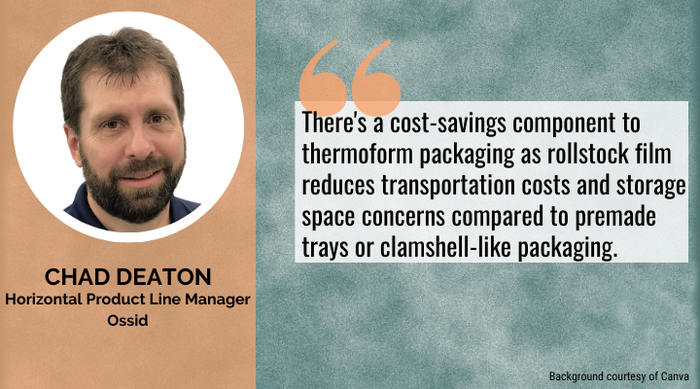Thermoformers are one of the best performing packaging machinery categories, according to a recent study. Here’s why.
June 8, 2022

A Freedonia Group analysis projects global demand for packaging machinery to expand 5.8% per year through 2026 to $71.1 billion. Although from a relatively small base, thermoforming machinery is expected to outperform most other product types.
According to the release published in late April, growth through 2026 for thermoforming equipment will be boosted by rapidly rising demand for blister, skin, and clamshell packaging due to their ability to extent the shelf-life and preserve the appearance of such products as meats, poultry, and seafood. The range of packaging applications include vacuum, blister, skin, modified/controlled atmosphere packaging, and other film-based shaped packages.
Chad Deaton is the horizontal product line manager (thermoform-fill-seal, tray sealing, flow wrapping, vacuum chamber) for Ossid, a North Carolina-based manufacturer of a range of packaging machinery. He responds to our thermoforming questions in this exclusive Q&A.

Among a wide range of packaging machinery, the study singles out thermoformers as having robust growth. Why might that be?
Deaton: I think a key factor to the growing success and popularity of thermoform packaging to both food processors and consumers is the flexibility it offers. For the processors, thermoform packaging allows for a great deal of customization — the tooling can be made to standard size or customized to fit the product’s intended packaged look.
Ossid is the North American master distributor for Reepack, a leading manufacturer of tray sealers, thermoformers and other food packaging machinery. Reepack’s thermoform-fill-seal product line offers customizable elements, mostly with respect to the length and output of the machine, if that is of interest to the customer.
For the consumers, thermoform packaging presents the product well. The first bites of any food are really with the eyes, and food packaged on a thermoformer really displays it in a very appealing manner. It can also extend the shelf life of food, which gives consumers extra time to cook it after purchase.
What’s happening in this market?
Deaton: It’s no surprise that food processors and consumers alike are looking for extended shelf life of the products they buy. The last thing a consumer wants is to have their steak, chicken, or other protein products become spoiled after just a few days. Thermoform packaging, specifically in the fresh protein market, really shines in this area through increasing shelf life, having a higher acceptance level in retail settings, and aiding in a brand’s pursuit of sustainable initiatives. There is also a cost-savings component to thermoform packaging as rollstock film reduces transportation costs and storage space concerns when compared to premade trays or clamshell-like packaging.
What markets present the most opportunity?
Deaton: The markets that seem to embrace the value of thermoform packaging are fresh proteins, seafood, and medical devices. That’s because it’s a highly versatile packaging option with many available materials. Thermoform packaging offers excellent product protection, displays the product well, and several film materials are sustainable.
What machinery features do you think contribute to that growth?
Deaton: Reepack machines are quite easy to use and maintain; the learning curve for operation is drastically reduced when compared with others in the industry. Reasons include human-machine interface (HMI) controls that are offered in dozens of languages, easy-open frame for ample access to check, adjust, and repair all parts of the machine, and a fast and easy product changeover.
You May Also Like


